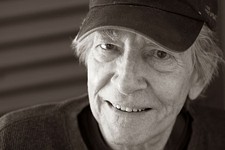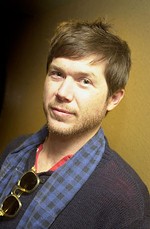Art That Speaks for Itself
By Clay Smith, Fri., Dec. 19, 1997
I now embrace this oppertunity of writing... to let you know where I am and where I am going. I am well, thank God, and in high Spirits. I am now on an expidition to the westward, with Capt. Lewis and Capt. Clark, who are appointed by the President of the united States to go... through the interior parts of North America. We are to ascend the Missouri River with a boat as far as it is navigable and then go by land, to the western ocean, if nothing prevents...
We expect to be gone 18 months or two years. We are to Receive a great Reward for this expidition, when we Return. I am to Receive 15 dollars pr. month and at least 400 ackers of first Rate land, and if we make Great Discoveries as we expect, the united States has promised to make us Great Rewards.... For fear of exidants I wish to inform you that I left 200 dollars in cash, at Kaskaskias... and if I Should not live to return, my heirs can git that and all the pay Due me from the U.S.... Government.
I...will write next winter if I have a chance. Sergeant John Ordway
I've mentioned before my reservations about coffeetable and art and photo books: Sure the pictures are pretty, but what about those often hackneyed, cursory, and sidelined words that accompany them? That neat categorization crumbles, however, when I encounter a book heavy on the pictures that also contains powerful, tragic passages like the one above, passages which dot Lewis & Clark: The Journey of the Corps of Discovery by Dayton Duncan and Ken Burns (Knopf, $40 hard). They are powerful and tragic because they are actually written by Lewis and Clark and the Corps of Discovery members, the first American citizens to trek the West (in 1804), not historical documentarians like Burns and Duncan. Lewis & Clark is one of the few books printed that's "based on a documentary film," a film of the same name by Ken Burns that premiered locally on KLRU in early November. The editors at Knopf have assembled a stellar team to contribute to the book, Stephen E. Ambrose, Erica Funkhouse, and William Least Heat-Moon, with the majority of the text by Duncan. Burns gets the preface, sign enough that he should stick to a visual medium. Describing the process of creating the film and companion book, Burns writes that he has undergone a search "to learn about the mysterious inner workings of this remarkable republic and those strange and complicated people who like to call themselves Americans." -- Oh honey, look, there's one of those strange Americans with a buckskin cap marching up the foothills of the Rockies and yelling, and oh my, there's a complicated -- that isn't a panther, is it?
But seriously folks, the book is thorough, illustrative, and well-designed. Nonetheless, it is difficult to get past the fact that the book's original source material, the Corps members' writings, is far more useful than the sometimes dry, plodding historical background provided by Duncan. In fact, while reading the book, I recalled history texts fed to me in junior high, texts whose authors attempt strenuously to engage readers in the subject by citing all sorts of "interesting" facts and anecdotes. Thus I harbor no qualms recommending that upon purchasing the book you head straight for the pictures, italicized text written by the Corps members, and contributions by Ambrose, Funkhouse, and Least Heat-Moon, perhaps a relief to you or a gift recipient during a stressful holiday season.
|
Benjamin Franklin's 1754 Join, or Die woodcut as shown in Eyes of the Nation. |
Vincent Virga, "author" along with the curators of the Library of Congress and Alan Brinkley of Eyes of the Nation: A Visual History of the United States (Knopf, $75 hard), writes at the end of this gargantuan tome, in his acknowledgments, about the potentially stressful but actually pleasant process of spending three years at the Library of Congress compiling images and text for the book. I don't place the word "author" in quotes to denigrate Virga's role; it's just that it's hard to understand in a work of this scope exactly who plays what role. It seems, though, that Virga approached Bernard Reilly, former head curator of the Prints and Photographs division of the Library, with the idea of a "visual history of America culled collaboratively from the Library's various collections," an idea Reilly got behind and convinced the Library administration would be a good one. It's a joy to read about Virga's "bliss" sitting "in a room with all of them [the curators] excitedly `constellating' a chosen image by adding related images to it, or discussing and conjuring visuals for a particular moment in our history," since Virga's bliss counters the usual images of unfriendly stacks of library materials and the bureaucratic nightmares that must accompany printing those materials; in short, it's a joy to know that someone is using all those materials and is printing those original materials, allowing them to speak for themselves about our nation's history. The "original materials" are items like maps, pages from a civil war soldier's sketch book, broadsides, and charcoal drawings. The authors use those items to celebrate U.S. history but simultaneously refuse to let its more sordid pockets slip away into oblivion. Take, for example, a seven-page section of photos at the back of the book entitled "The People," which includes photos of Americans like Carl Van Vechten, Greta Garbo, and Walt Whitman, but also a Native American, unidentified; tobacco workers, unidentified; garage mechanic, unidentified; and a U.S. Capitol police officer, unidentified. It's certainly arguable whether the cultural tendency to document the names only of VIPs is unique to American culture, but this section of "people" stands as a mere microcosm of the powerful statements this visual compendium makes about American history. Eyes is the kind of book to leave on a coffeetable for years and years, returning to it to glance at its documents again, leaving it there in the hopes that (back to junior high) the young, those uninitiated to reading about American history, can first see what it is all about.
Time has rendered the grave bond of secrecy between 17th-century alchemists null and void, and in place of that gravity there now appears an innocence to rhymes like the one below, which appears in The Golden Game: Alchemical Engravings of the Seventeenth Century by Stanislas Klossowski de Rola (Thames & Hudson, $27.50 paper):
Also he must (be never soe loath)
Receive it with a most dreadfull Oath
That as we refuse greate dignitie and fame,
Soe he must needly refuse the same.
Though a picture-book by any other name is... sometimes a catalogue, sometimes a compendium, I'm still at a loss as how to categorize this book, which is really more a beautiful cataloguing of its subject matter than anything else. The book has some 533 illustrations, which for an alchemical layman like myself means that I can flip through the book admiring the intricacy of the engravings, pondering their hidden meanings, content to become a bit more familiar with the subject. But for the expert, the book must be the wealthiest of sources, since in addition to its engravings, the author writes a brief biography of all the major figures of 17th-century alchemy and writes notation about each engraving, including the translations of Latin text. (Though you should be able to find this title at local bookstores, it's possible they won't have many copies of it; call 800/233-4830 if you're unable to find it locally.)
|
|
|
|











